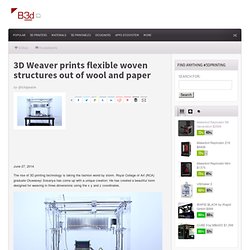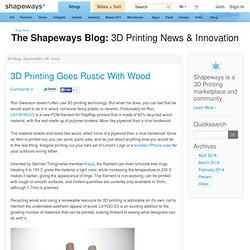

3D Weaver prints flexible woven structures out of wool and paper. June 27, 2014 The rise of 3D printing technology is taking the fashion world by storm.

Royal College of Art (RCA) graduate Oluwaseyi Sosanya has come up with a unique creation: He has created a beautiful loom designed for weaving in three dimensions using the x y and z coordinates. The 3D Weaver was designed for Sosanya’s The Structure of Protection graduate project. Similar as 3D printing’s layer process, Sosanya’s concept weaves together layers of material at different heights to create 3D shapes. 3D Printing a Greener Alternative to Traditional Manufacturing. It takes up to 64 percent less energy to create the things you need in your home with a 3D printer versus making them in a traditional factory and shipping them overseas to American consumers, according to a recent study out of Michigan Tech University.

"The bottom line is, we can get substantial reductions in energy and CO2 emissions from making things at home," Dr. Joshua Pearce, who conducted the study, said. "And the home manufacturer would be motivated to do the right thing and use less energy, because it costs so much less to make things on a 3D printer than to buy them off the shelf or on the Internet. " The world's first Carbon Fiber 3D Printer.
Soft plastic. A shoe designed using Shapeways' new Elasto Plastics material Image Gallery (3 images) Shapeways, one of the biggest names in 3D printing, is adding a new squishy plastic material called Elasto Plastics to its available printing options. This new material offers some interesting applications for anything wearable, specifically for sandals and other kinds of footwear. The material is off-white in color, and quite a bit more flexible than most other printable materials. Metalli. Taulman 645 - High Strength Material. Kyle Maxey posted on April 09, 2013 | Comment | 2978 views Taulman, makers of thermoplastic 3D printing filament, has announced its newest material, Taulman 645.

According to the company, the new material has a very high tensile strength (16,533 psi) and, as is demonstrated in the video below, it also has excellent bridging performance. An added feature of Taulman 645 is the fact that is designed to have a “superior surface texture” that’s clear and optically correct, although the materials specification sheet does mention that it lacks a UV inhibitor additive, which could lead to discoloration after long-term exposure to UV rays. Taulman 645 has also been designed to meet the EU’s REACH environmental requirements, and it contains no toxic chemicals, so any parts made from the material can be safely exported abroad. Build Your Own 3D Printer Filament Extruder. Have you ever wanted to turn your plastic trash into plastic treasure?

Well you may be in luck if you have a few spare parts laying around your garage. An Instructables was posted yesterday in which Ian McMill explains how anyone can create their very own 3d printer filament factory, allowing you to turn plastic bottles and other items into 3D printer filament. The machine actually works fairly fast.
Cheap filament. Micro Structures in Seconds. Nanoscribe, a spin-off from the Karlsruhe Institute of Technology in Germany, has developed a tabletop 3-D microprinter that can create complicated microstructures 100 times faster than is possible today.

“If something took one hour to make, it now takes less than one minute,” says Michael Thiel, chief scientific officer at Nanoscribe. 3DP Materials Review. The list not exhaustive — and it is certain to keep growing over time: Wood: The New-comer The newcomer in the group of 3Dprinting filament materials is wood.

The material itself is a mix of wood particles and polymers, which can be used to 3Dprint objects that kind of look like cardboard more than real wood. What is positive about it is that the print texture is simply beautiful and it hides print layers nicely, without making extremely thin layers. Mcor Iris paper 3Dprint. NanoPrint. Carta. Printed Optics. Disney Research, Pittsburgh Printed Optics is a new approach to creating custom optical elements for interactive devices using 3D printing.

Printed Optics enable sensing, display, and illumination elements to be directly embedded in the body of an interactive device. Using these elements, unique display surfaces, novel illumination techniques, custom optical sensors, and robust embedded components can be digitally fabricated for rapid, high fidelity, customized interactive devices. Printed Optics is part of our long term vision for the production of interactive devices that are 3D printed in their entirety. Future devices will be fabricated on demand with user-specific form and functionality. Research Paper Printed Optics: 3D Printing of Embedded Optical Elements for Interactive Devices. Head for viscous liquids. Oct.11, 2012 TNO has been working for a long time developing Additive Manufacturing technology.

Recently TNO researchers have developed a print head that can handle viscous liquids. This allows computer controlled 3D printer to work with stronger objects. Currently DIY 3D printers can build complex objects by extruding tiny droplets of liquid plastic through extruder but the printed objects are often not strong enough. To be able to print with a conventional print head, the material must be thin liquid and that means the monomers (long molecular chains, the building blocks of a plastic) is short. Materials. Fabbster materials fabbster uses a new, revolutionary material concept: SDM - stick deposition moulding.

The extruder of the printer is fed with special sticks developed by the fabbster team. Wooden filament. Ron Swanson doesn't often use 3D printing technology.

But when he does, you can bet that he would want to do it in wood, not some fancy plastic or ceramic. Fortunately for Ron, LAYWOO-D3 is a new FDM filament for RepRap printers that is made of 40% recycled wood material, with the rest made up of polymer binders. More like plywood than a nice hardwood. The material smells and looks like wood, albeit more of a plywood than a nice hardwood. Once an item is printed out, you can sand, paint, saw, and do just about anything else you would do to the real thing.
Electronics. Density control. Multimateriale. Rio de Janeiro's legendary Arena Maracanã was originally built for the 1950 World Cup. More than 60 years later, it is still looking beautiful thanks to a recent renovation project by architectural firm Fernandes Arquitetos Associados. Stratasys has captured the excitement and sleek new design of the renovated Maracanã with this unique 3D printed version. Working with STL files provided by Fernandes Arquitetos Associados, we 3D printed Maracanã on the Objet500 Connex Multi-material 3D Printer ( using rigid opaque (VeroWhitePlus) material ( The model was assembled from just two parts -- the roof and the base. Architects and other designers the world over are using Stratasys 3D printing to test their designs and present them to their customers for immediate feedback. Oggetti robusti. Polimeri flessibili. The Semi-Rigid Concept car, designed by Emergent, is a whirlwind of design. The concept solves quite a few of our current transportation issues by moving the world of biology into the vehicle construction process.
Built with a 3D printing technique that creates an outer body that is similar in texture and form to cartilage -- and just as resiliant -- the car is able to withstand and bounce back after any external impact. Continuing with their outside of the box car-frame thinking, Emergent decided to take this bio-construction a bit further and place an independent fuel source right inside car - that's right, this curvy vehicle of the future makes its own biofuel! The 3D printing technique used to create the outer body of this car constructs layers of a cartilage-like material through new molecular constructions of polymers, resins, rubbers and silicone, which are placed on the car’s frame in alternating thicknesses.
Drugs (Stàmpati ‘na pastiglia) Clothing materials. Printing in gel: freeform and undo.